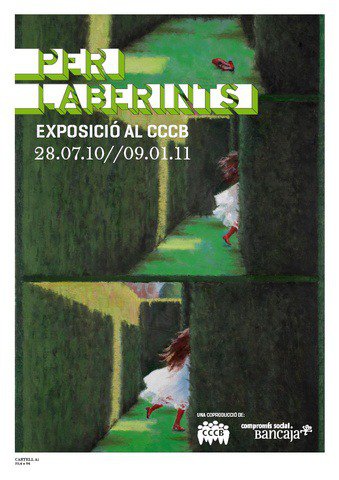Through Labyrinths
dal 26/7/2010 al 8/1/2011
Segnalato da
Monica Munoz - CCCB Press Department
Robert Morris
Terry Fox
Richard Long
J.L. Borges
Randoll Coate
Patrick Ireland
Michael Ayrton
Friedrich Durrenmatt
Saul Steinberg
Josep Ma. Subirachs
Ramon de Soto
Oscar Tusquets
26/7/2010
Through Labyrinths
Centre de Cultura Contemporania de Barcelona CCCB, Barcelona
Group Show. The exhibition reviews the representation of the labyrinth throughout history, making a clear distinction between single-path labyrinths and mazes, labyrinths with a choice of paths, and reflecting on the relevance of this element and different practices and uses today. On show a series of varied spaces illustrated by works with a variety of different sources, formats, authors and periods, such as archaeological pieces, engravings, photographs, maps, screenings and models, plus specially created audiovisual, animated and interactive pieces.

curated by Oscar Tusquets
The labyrinth as a construction and a symbol is present in many cultural traditions. As explained by Eco (author of the foreword to the exhibition catalogue), the thousands of years of history of this figure reveal the fascination it has always held for humankind, representing as it does an aspect of the human condition: there are countless situations that are very easy to get into, but more difficult to extract oneself from.
This exhibition, scripted by Ramon Espelt, curated and designed by Oscar Tusquets, with Jorge Wagensberg as advisor, reviews the concept and representation of the labyrinth throughout history, making a clear distinction between single-path labyrinths and mazes, labyrinths with a choice of paths, and reflecting on the relevance of this element and different practices and uses today.
The exhibition comprises a series of very varied spaces illustrated by works with a variety of different sources, formats, authors and periods, such as archaeological pieces, engravings, photographs, maps, screenings and models, plus specially created audiovisual, animated and interactive pieces.
Artist: Michael Ayrton, Jorge Luis Borges, Antonella Bussanich, Randoll Coate, Nick Coombe, Friedrich Dürrenmatt, Umberto Eco, Michele Emmer, Terry Fox, Martha Graham, Richard Long, Luis Longhi, Robert Morris, Lika Mutal, Ben Nicholson, Brian O’Doherty/ Patrick Ireland, Pierre Rosenstiehl, Ramón de Soto, Saul Steinberg, Josep Maria Subirachs, Oscar Tusquets, Jorge Wagensberg, Teri Wehn-Damisch.
Fields:
1. Plaza
A shade structure will be created in the Pati de les Dones courtyard, with the floor plan of a rectangular labyrinth. The shade structure will be suspended over the arches at the entrance and comprise a system of cables supporting elements that will form the layout of the labyrinth. The shadows cast by this structure on the ground and the walls of the courtyard will form a labyrinth that changes with the sun’s position, which visitors can observe and walk around.
2. Unicursal Labyrinths
The layout of this space will be intricate, but there will only be one way out, in keeping with the aim of all unicursal labyrinths: the longest route on the smallest surface area (the divisions will be no more than a metre high).
An initial distinction will be made between conceptual labyrinths, drawn on stone or paper, which we can follow visually or trace with a finger, and labyrinths that we can physically enter and walk around. This sector will include stone engravings; the Cretan labyrinth represented on coins and Greek pottery; Roman mosaics; labyrinths from Gothic cathedrals; labyrinths as memorials; facsimiles of medieval manuscripts and various books from the 16th to 19th centuries that contain representations of the labyrinth.
It also presents the work of contemporary artists such as Robert Morris, Terry Fox and Richard Long, for whom historical labyrinths are a source of inspiration, bringing the representation of the unicursal labyrinth up to the present day.
This space ends with a room devoted to the figure of the Minotaur and the relationship between the labyrinth and dance.
3. Crisis in the Concept of the Unicursal Labyrinth
This section will analyze issues such as the uselessness of Ariadne’s thread in a unicursal labyrinth. It also focuses on Giovanni Fontana (15th c.), the creator of the first intentionally designed mazes that offered the freedom to choose a route at various turning points and the possibility of getting lost after reaching various dead ends.
The maze raises the issue of the need for Ariadne’s thread to find one’s way out, as an “external memory” that helps us to retrace our steps to the entrance to the labyrinth. A room will be given over to the relation between labyrinth and memory, with an ants’ nest as a central feature that explores the theme from the viewpoint of the natural sciences.
4. Mazes
As opposed to the unicursal labyrinth, the layout of this space will offer a range of alternatives, possibilities of choice and dead ends, with walls extending above eye level, unlike the unicursal labyrinth, in which the divisions are lower.
Here, the entrance centres on the hedge labyrinths that were planted in numerous aristocratic gardens in Europe between the 16th and 18th centuries. The layout divides into different rooms that will develop themes associated with real places (the labyrinth at Versailles) or creators (writers, architects, artists: Borges, Randoll Coate, Patrick Ireland, Michael Ayrton, Friedrich Dürrenmatt, Saul Steinberg, etc.) whose body of work features the theme of the labyrinth.
This space will also include a walk-through maze of mirrors and a room with an audiovisual installation that looks at the role of the labyrinth as a space of life in the cinema.
Press Service of the CCCB
Mònica Muñoz – Irene Ruiz – Elisabet Vilalta
Montalegre, 5 – 08001 Barcelona 93 3064123/ 93 3064143 premsa@cccb.org
Centre de Cultura Contemporania de Barcelona CCCB
calle Montalegre 5, Barcelona
Hours: tue-sun and public holidays 11am-8pm, thu 11am-10pm
Regular admission 4.50, combined admission to two exhibitions 6, concessions: 3.40 on wed and for senior, large families, students under 25, free for under 16, friends of the CCCB, senior citizens on presentation of a Targeta Rosa, the unwaged, and on the first wednesday of the month and thursdays between 8 and 10pm



